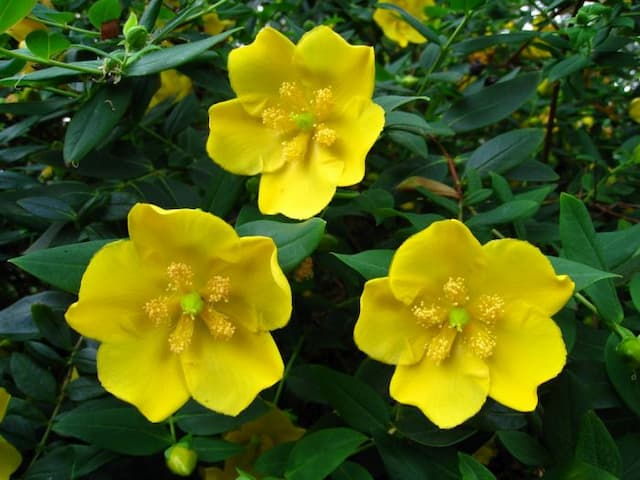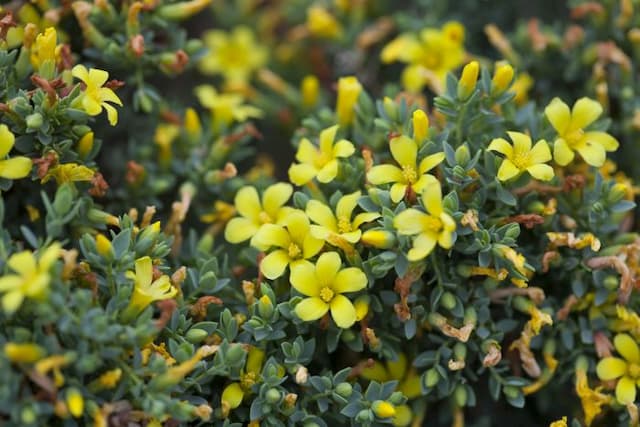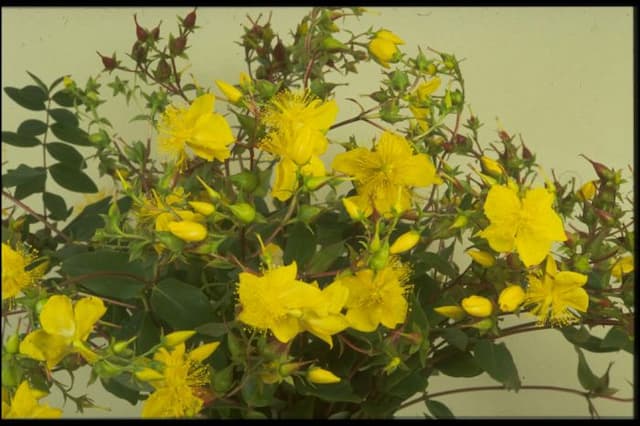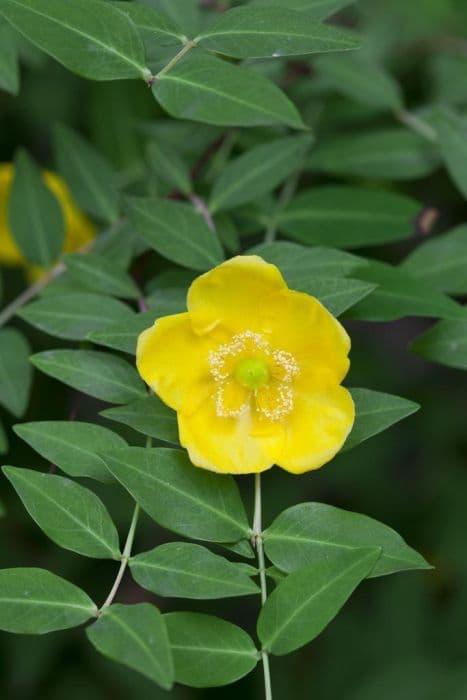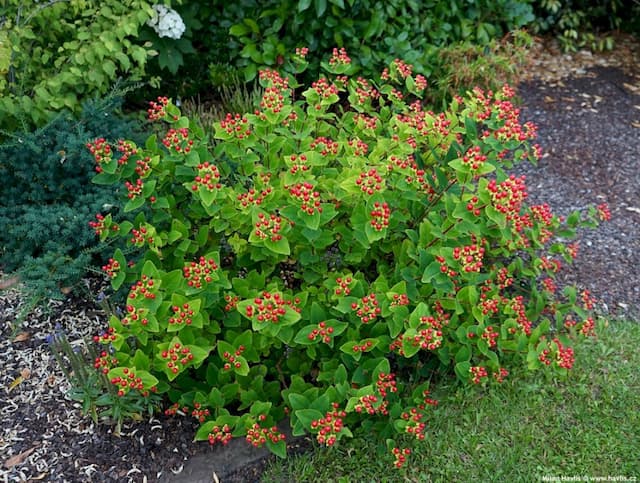Forrest's St. John's Wort Hypericum forrestii

ABOUT
Hypericum forrestii, commonly known as St. John's wort, is a perennial shrub that displays a lush, bushy appearance. The plant is characterized by its oval to oblong leaves that possess a deep green color, providing a striking backdrop for its flowers. These leaves are glossy and may have a slightly leathery texture, with a few visible veins running through them. Flowering predominantly in the summer, St. John's wort produces a profusion of bright yellow flowers. Each flower is composed of five petals that exhibit a delicate, almost translucent quality, and they are adorned with numerous stamens that create a frilly, brush-like center. The flowers are arranged in cymes, giving a clustered look that adds to the visual appeal of the plant. The plant's bark is often smooth with a peeling texture, and the branches may arch gracefully. Beneath the plant, the root system is well-developed, anchoring it firmly into the soil and providing support for the above-ground foliage and blooms. Overall, Hypericum forrestii has a robust yet refined appearance, making it a popular choice for ornamental gardens due to its attractive foliage and sunny, cheerful flowers. It is also valued for its resilience and low-maintenance characteristics, often used in borders or as a decorative ground cover.
About this plant
 Names
NamesFamily
Hypericaceae
Synonyms
Forrest's St. John's Wort, Forrest's Tutsan
Common names
Hypericum patulum var. forrestii.
 Toxicity
ToxicityTo humans
Hypericum forrestii, commonly known as St. John's Wort, is not typically considered highly toxic to humans when touched or ingested in small quantities. However, in some individuals, it can cause adverse effects if consumed in significant amounts or if they have particular sensitivities. Symptoms of St. John's Wort poisoning may include gastrointestinal discomfort, such as nausea, vomiting, and diarrhea, as well as confusion and dizziness. In extreme cases, it can lead to photosensitivity, resulting in skin irritation and increased susceptibility to sunburn when exposed to sunlight.
To pets
Hypericum forrestii, commonly known as St. John's Wort, can be toxic to pets, most notably dogs and cats, if ingested. Symptoms of poisoning in pets may include skin irritation, particularly after sun exposure due to photosensitizing compounds in the plant. If consumed in large quantities, it can also cause gastrointestinal upset, manifesting as vomiting and diarrhea. In severe cases, ingestion of St. John's Wort may result in more serious symptoms such as damage to the nervous system, leading to lethargy, incoordination, and potentially seizures. It is important to keep pets away from the plant and to contact a veterinarian if you suspect they have consumed any part of it.
 Characteristics
CharacteristicsLife cycle
Perennials
Foliage type
Evergreen
Color of leaves
Green
Flower color
Yellow
Height
2 feet (0.61 meters)
Spread
2 feet (0.61 meters)
Plant type
Shrub
Hardiness zones
7
Native area
China
Benefits
 General Benefits
General Benefits- Aesthetic Appeal: Hypericum forrestii, commonly known as St. John's Wort, adds a decorative element to gardens with its bright yellow flowers and attractive, bushy form.
- Low Maintenance: St. John's Wort is known for its low maintenance requirements, making it suitable for gardeners of all skill levels.
- Drought Tolerance: This plant is relatively drought-tolerant, which can reduce the need for frequent watering once established.
- Wildlife Attraction: The bright flowers of St. John's Wort attract pollinators such as bees and butterflies, supporting local ecosystems.
- Erosion Control: Its dense growth habit can help stabilize soil in areas prone to erosion.
- Year-Round Interest: With flowers in the summer and persistent fruits or seed capsules, St. John's Wort provides visual interest throughout multiple seasons.
- Landscape Versatility: It can be used in various landscape settings including borders, rock gardens, and as ground cover.
- Hardiness: It's generally hardy and can withstand a variety of climatic conditions, making it suitable for multiple gardening zones.
 Medical Properties
Medical PropertiesThis plant is not used for medical purposes.
 Air-purifying Qualities
Air-purifying QualitiesThis plant is not specifically known for air purifying qualities.
 Other Uses
Other Uses- Hypericum forrestii, commonly known as St. John's Wort, can be infused in oil to create a natural wood stain that gives a warm, reddish glow to wooden furniture.
- The bright yellow flowers of St. John's Wort can be used as a natural dye for fabrics, providing shades of yellow to orange depending on the mordant used.
- The plant's dense growth habit makes it suitable as a low hedge in landscaping, offering structure and color in garden design.
- The attractive berries of St. John's Wort can be used for decorative purposes in floral arrangements and wreath-making during the autumn season.
- The aromatic quality of the leaves can be exploited by using them in potpourri mixes to impart a subtle, herbaceous fragrance to the home.
- Because of its dense and bushy form, St. John's Wort can be planted to provide erosion control on slopes and prevent soil degradation.
- The plant's ability to thrive in poor soil conditions makes it ideal for reclaiming and revitalizing disturbed lands, such as former mining sites.
- Often used in xeriscaping, St. John's Wort is drought-tolerant and ideal for water-conserving gardens.
- The flowers can be used to create a natural insect repellent by crushing the petals to release the oils that some insects may find unattractive.
- In craft activities, the leaves and flowers of St. John's Wort can be pressed and included in homemade paper for a decorative touch.
Interesting Facts
 Feng Shui
Feng ShuiThe St. John's Wort is not used in Feng Shui practice.
 Zodiac Sign Compitability
Zodiac Sign CompitabilityThe St. John's Wort is not used in astrology practice.
 Plant Symbolism
Plant Symbolism- Protection: Hypericum, commonly known as St. John's Wort, is often associated with warding off evil spirits and negative energies. It's traditionally used in various cultures to protect against supernatural forces.
- Healing: St. John's Wort is well-known for its medicinal properties, particularly in treating depression and anxiety, which makes it a symbol of mental health and healing.
- Strength: The hardy nature of St. John's Wort, with its ability to thrive even in poor soils, makes it a symbol of resilience and inner strength.
- Celebration: Its association with the feast day of St. John the Baptist has made St. John's Wort a plant representative of joy, celebration, and the triumph of life at midsummer.
- Life and Vitality: With its vibrant yellow flowers, St. John's Wort embodies brightness, life energy, and the vigor of nature.
 Water
WaterSt. John's Wort prefers regular watering to maintain moist but not waterlogged soil. During the growing season, water thoroughly once every week, using approximately 1 gallon per plant, depending on size and environmental conditions. Allow the top inch of soil to dry out before watering again. During winter, reduce watering frequency to bi-weekly, monitoring the soil moisture to avoid overwatering. Adjust the amount of water based on rainfall and temperature, ensuring proper drainage to prevent root rot.
 Light
LightFor optimal growth, St. John's Wort should be situated in a spot where it receives full sun to partial shade. The plant thrives best in bright, indirect sunlight for at least six hours a day. If grown indoors, a south-facing window is ideal to ensure that the plant gets enough natural light without being exposed to harsh afternoon sun.
 Temperature
TemperatureSt. John's Wort is hardy and can tolerate a temperature range from about 10°F to 90°F. However, the ideal temperature conditions for this plant would be between 50°F and 75°F. The plant can survive occasional temperature dips below freezing, but prolonged exposure to extreme cold or heat will be detrimental.
 Pruning
PruningPruning St. John's Wort is important to encourage bushy growth and prevent legginess. Prune in early spring, removing any dead or damaged wood and shaping the plant as desired. It's also beneficial to trim back about a third of the old growth to promote new, vigorous shoots. Pruning can be done annually, after the last frost has passed.
 Cleaning
CleaningAs needed
 Soil
SoilSt. John's Wort (Hypericum forrestii) thrives in a well-draining, loamy soil mixture with an acidic to neutral pH range of 5.5 to 7. A mix of garden soil, peat moss, and perlite or sand is ideal to provide aeration and proper drainage.
 Repotting
RepottingSt. John's Wort (Hypericum forrestii) should generally be repotted every 2-3 years to refresh the soil and accommodate root growth. Make sure to repot in the spring when the plant is beginning its active growing cycle.
 Humidity & Misting
Humidity & MistingSt. John's Wort (Hypericum forrestii) prefers moderate humidity levels and is adaptable to the typical indoor environment; striving for a range of 40-60% humidity will provide optimal growing conditions for this plant.
 Suitable locations
Suitable locationsIndoor
Bright indirect light, moderate humidity, well-draining soil.
Outdoor
Plant in partial sun to dappled shade; protect from harsh elements.
Hardiness zone
6-9 USDA
 Life cycle
Life cycleThe life cycle of St. John's Wort (Hypericum forrestii) begins with seed germination, which requires exposure to light and may occur over several weeks. Seedlings develop a root system and grow into juvenile plants, forming a rosette of leaves at the ground level. The plant enters a vegetative growth phase where it develops characteristic oblong leaves and a woody stem, eventually reaching maturity. During the flowering stage, usually in early to mid-summer, it produces bright yellow flowers with numerous stamens. After pollination, typically by insects, the flowers develop into capsules filled with numerous tiny seeds. Once mature, the seed capsules release the seeds to complete the cycle, while the adult plant may continue to grow and flower for several years.
 Propogation
PropogationPropogation time
Spring-summer
Propogation: Hypericum forrestii, commonly known as Forrest's St. John's Wort, is typically propagated by semi-hardwood cuttings taken in the late summer. The most popular method involves selecting healthy, non-flowering shoots from the current year's growth. Cut a 4 to 6 inch (10 to 15 cm) piece of stem with several leaves, ideally in the morning when the plant is fully hydrated. The lower leaves should be removed and the base of the cutting dipped in a rooting hormone before being inserted into a pot filled with a mix of peat and perlite. The cutting should then be placed in a well-lit area, avoiding direct sunlight, and kept moist. Roots often develop within several weeks, after which the new plant can be gradually acclimatized to outdoor conditions before planting out the following spring.
